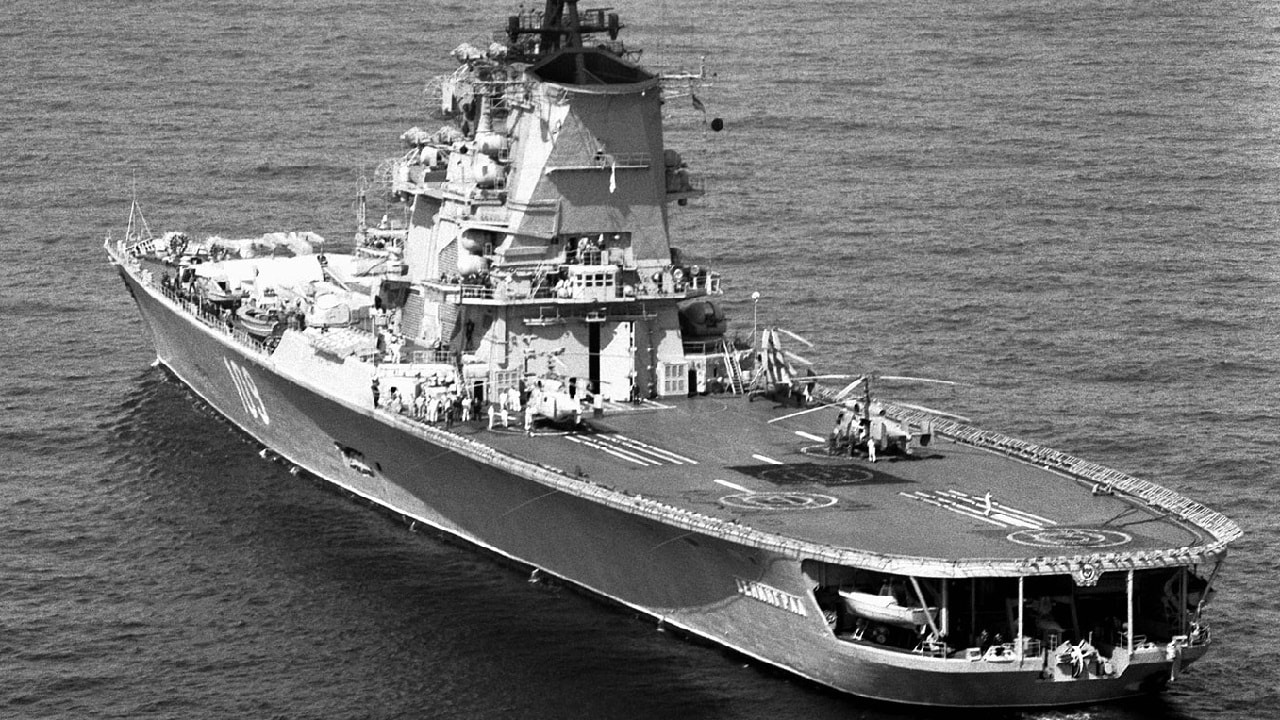Moskva: The Curious Case of the Soviet Helicopter Carrier – It wasn’t really an aircraft carrier in the traditional sense, but it was much more than a surface combatant. The Soviets had a helicopter carrier, or more specifically, a helicopter cruiser called the Moskva-class. This consisted of two ships, the Moskva and the Leningrad. These ships are curious. They were meant for anti-submarine warfare, but were quickly made obsolete by more advanced nuclear, long-range submarines and their ballistic missiles from the United States.
Let’s examine these warships in finer detail because they are an interesting story of a good idea that was overcome by events during the Cold War.
History and Concept Behind the Moskva-class
The Soviets began to conceptualize the Moskva-class in the late 1950s. By the early to mid-1960s, both the Moskva and her sister ship the Leningrad were laid down and they both entered service by 1969. The idea behind the helicopter cruisers was to protect the homeland by bringing the anti-submarine fight far from shores to thwart the American attack and ballistic-missile submarines that were menacing the Soviet Union.
Go After the U.S. Boomers
The Soviets were especially concerned about ballistic missile boats or “boomers.” If the boomers were going to attack in a nuclear war scenario, the Russians wanted to destroy these boats before they could fire their missiles. That’s where the helicopters came in. Between 14 and 18 of them were able to take off and land from each helicopter cruiser.
Chock Full of Weapons
The Moskva-class ships also had their own vast defensive capabilities. They were stacked with armaments. Anti-submarine rockets could be fired at enemy subs. Numerous depth charge launchers adorned the ship from bow to stern.
For enemy nuclear-submarines that were traveling fast and deep, the Soviets had rocket-thrown depth bombs to strike nuclear-powered subs. Four 533mm torpedo launchers were mounted amidship. The helicopter cruisers were vulnerable to attacks from airplanes, so the Moskva-class had two twin-arm surface-to-air missile launchers with up to 96-interceptors on board. 57mm cannons were also available for shore bombardment.
Multi-Role Ship If Needed
The Moskva-class was meant for patrolling operations in support of a larger strike group. But the Moskva and the Leningrad could also serve as the flagship of a flotilla. The ships were 620-feet long and displaced nearly 15,000 tons.
What Helicopters Did It Carry?
The ships’ Kamov Ka-25 Hormone helicopters turned heads when they entered service in 1966. The first thing you noticed was their short body that was truncated in order to fit as many helicopters on board as possible. The Ka-25 had two main rotors but no tail rotor. The Ka-25 quickly became a workhorse for the Soviet navy’s efforts in anti-submarine warfare and combat search and rescue. The helicopter could carry torpedoes and depth charges. The aircraft soon spread around the Soviets navy and 450 were built.
The Moskva-class ships soon had a problem. The Soviets built them focusing on submarines that would come closer to shore. The Americans in the 1950s and early 1960s had ballistic missiles with shorter ranges. This played to the Moskvas’ advantages in undersea warfare.
The Moskvas Were Quickly Made Obsolete
Then warfare changed. In 1964, the Americans introduced the Polaris A-3 nuclear-tipped ballistic missile that carried a one-megaton warhead. This missile had a range of 3,000 miles. And it meant that the Americans could fire stand-off missiles outside the range of the Moskva-class. U.S. subs that had the Polaris A-3 could sail as far away as the United Kingdom and fire missiles that could hit targets deep in the Soviet Union. Unfortunately for the Russians, the Moskva and the Leningrad were obsolete before they were introduced. They were kept in service until after the Cold War in 1996 and finally scrapped in 1997.
Bring It Back from the Dead?
Since then the Russians had only one aircraft carrier – the unlucky Admiral Kuznetsov that will be in dry dock this summer after a history of deadly mishaps – could the Russians bring the helicopter carrier back and use it to launch drones? This would make sense as the helicopter cruisers could be armed with Kalibr-cruise missiles for deep land-attack strike missions.
But this ship would be limited to carrying only a handful of helicopters that would not make much of a difference in anti-submarine warfare. The Russians are not known for producing surface ships that are on time and under budget. The cost would be prohibitive. Due to these drawbacks, it appears the helicopter cruiser will not come back any time soon to the Russian fleet.
Now serving as 1945’s Defense and National Security Editor, Brent M. Eastwood, PhD, is the author of Humans, Machines, and Data: Future Trends in Warfare. He is an Emerging Threats expert and former U.S. Army Infantry officer. You can follow him on Twitter @BMEastwood.

